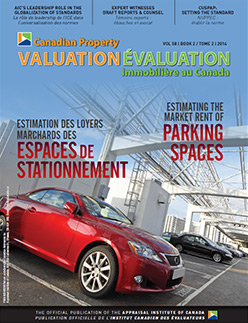Guideline to estimating the market rent of parking spaces
Canadian Property Valuation Magazine
Search the Library Online

By D. Allan Beatty, AACI, P. App., Fellow
Author of the Guideline and Chair of the Appeal Sub-Committee
“While independent, reliable estimates of market parking rents are often associated with the calculation of taxable benefits; the Guideline applies to any situation where such rents are to be estimated.”
The Appraisal Institute of Canada (AIC), in collaboration with l’Ordre des agréés du Québec (OEAQ), and with the support of Public Works and Government Services Canada (PWGSC), has recently developed a Guideline to Estimating the Market Rent for Parking Spaces.
At the request of PWGSC, the Guideline was commissioned to assist real estate appraisers who provide parking rate reports directly to them. But, it goes further than that. The intent is to improve the consistency in appraisal reporting across Canada, to ensure opinions for parking rents are objective and well supported, and provide guidance to practitioners on an industry-wide basis. It also reflects the requirements of the standards of professional practice of the AIC and OEAQ, Canada’s two leading appraisal organizations, as well as recent Canadian jurisprudence on the market rental of parking rents.
It is important to note that, while PWGSC commissioned the project, the “Guideline is intended to outline best practices for estimating the market rent for parking spaces. While independent, reliable estimates of market parking rents are often associated with the calculation of taxable benefits; the Guideline applies to any situation where such rents are to be estimated.”1 Published March 1, 2014, the Guideline will be refreshed as required, particularly if new types of parking are developed or new case law evolves.
Of interest are recent court decisions in the Federal Court of Appeal for Canada and at the Tax Court of Canada, which recognized that the application of the Appraisal Standard Rules of the AIC’s Canadian Uniform Standards of Professional Appraisal Practice (CUSPAP) was appropriate for this type of assignment (as opposed to the Consulting Standard in CUSPAP). They also confirmed in their ruling that fair market rent is the proper measure for calculating parking rents for taxable benefit purposes, and that the Direct Comparison Approach was the applicable valuation methodology.
Beyond this case, surprisingly little has been written on this specific topic to provide guidance to practitioners. It is the hope that the Guideline will provide a reference point for definitions of common terminology relating to parking. In addition, the Guideline provides suggestions on developing proper terms of reference and best practices for developing reliable adjustments in the comparison process. The intent is to assist both the competent appraiser and their clients in setting clear objectives for valuing this unique property interest.
The Guideline provides definitions for parking types and categories (open and closed markets, campus or stand-alone, and compound). The Open Market category, for example, relates to neighbourhoods where parking is publically available, typically with a wide range of choice for the parking customer. Closed Market parking, in contrast, is usually limited to a specific type of customer, such as the occupants of an office complex. It is recognized that each category can include different types of parking.
Parking types
While not a definitive list, the following examples are provided to assist the practitioner in defining the interest being appraised.
Unreserved, random or rush parking
Monthly parking passes ensure parking during business hours is usually available, but not in an assigned space. This parking type is sometimes found in areas where there can be peak demand for parking after business hours, which is publically available on a metered basis. The appraiser should determine if the permit holders are allowed access to parking after business hours, as it can affect the price. This parking type is sometimes referred to as ‘reserved but unassigned.’
Reserved parking
A specific parking space is reserved for the permit holder, which can be on a 24-hour basis, or subject to reserved status only during business hours.
Scramble parking
Employee parking is provided, but with far fewer spaces available than the overall demand – it is occupied on a first-come first-served basis. On any given day, an employee may not find available parking. This type of parking is not usually considered as a taxable benefit, according to Canada Revenue Agency rules (see Appendix D of the Guideline for the web link to the publication.
Premium parking
While not a ‘type’ per se, there can be premiums (or discounts) within a parking structure or between parking lots (in a campus setting) depending on convenience relative to key facilities such as a specific building, building entrance or elevator lobby. Sometimes, spaces are discounted for being the most remote, or on the top floor of a parking garage, thus offering less convenient access and more exposure to the elements.
Surface parking
Parking rents can vary within sub-categories, depending on the quality of the parking lot and the parking experience/rentability. For example, even comparably located surface parking lots may vary in price depending on the parking surface, i.e., whether it is paved or not. The research must be sufficient to determine if pricing varies for these types of factors, and adjust as necessary.
While these descriptions are meant to be illustrative, the key factor for consideration is that the type of parking can affect its market rent. So too can parking services such as the availability of electricity. The appraiser must investigate the comparables to ensure that comparisons are made of like to like. It is the marketplace that determines if the type of parking affects rents within each of the classifications described earlier and a supportable opinion requires a complete understanding of the relationship between parking categories, parking types and parking rents.
“Client groups that have requisitioned market parking studies have indicated that the quality of report they receive has varied widely. The most common criticism is the lack of meaningful analysis, or adequate support for adjustments.”
Defining the terms of reference
In addition to the advice directed at the appraisal community, it is also hoped that the entities engaging appraisers will reference the Guideline. Terms of Reference (TOR) can vary from assignment to assignment, depending on the needs of the client, and subject always to the appraiser performing their work in accordance with their professional obligations. TORs should include, but not be limited to, the following:
- whether the categories of parking under study will be classified as defined in the Guideline, or whether other definitions are to be applied for the specific assignment;
- the specific Types of parking under study;
- the intended use of the market parking study and the intended user(s) of the report;
- whether rents are to be inclusive of taxes, and/or surcharges;
- expectations or requirement for inspection of the property;
- expectations or requirements to inspect comparables; and
- extraordinary assumptions (if any) applicable to the assignment.
Scope of work
Once agreement is reached on the TOR, it is the appraiser’s responsibility to design the proper scope of work to satisfy the client’s intended use for the report, including but not limited to the following:
- the degree to which the property is inspected or identified;
- the extent of research into physical or economic factors that could affect the property;
- a forecast of future changes in supply and demand conditions;
- the extent of data research, including inspection of comparables; and
- the type and extent of analysis applied to arrive at opinions or conclusions.
Appraisal reporting
Appraisal reporting requirements vary between organizations, and practitioners have an obligation to perform their services in accordance with their standards of practice. Important minimum compliance requirements for this specific type of assignment include:
- indicating the intended use of the report, and the intended user(s);
- stating the purpose or goal of the report;
- indicating the effective date of the opinions and conclusions;
- providing an appropriate definition of the value to be determined;
- indicating the date of the report;
- indicating the date of inspection;
- describing the scope of work;
- identifying and describing the real property (immovable) in accordance with TOR;
- considering highest and best use, when relevant to the assignment;
- summarizing details and analysis of all data relevant to the assignment;
- employing appraisal procedures relevant to the assignment;
- detailing the reasoning supporting the analyses, opinions and conclusions;
- analyzing the effect on value, if any comparables are held under lease;
- reviewing and reconciling the data, analyses and conclusions;
- providing a final value estimate stating the parking category and type;
- including a statement of Limiting Conditions or Reservations and Basic Assumptions;
- describing any extraordinary assumptions, reservations, or hypothetical conditions;
- including a signed certification of the report; and
- including such visual aids as appropriate.
(Note: This could be a TOR issue for the client, if, for example, photographs of the parking comparables were important. At a minimum, a map outlining the extent of the study area is recommended, showing the location of the subject and comparables.
Appraisal analysis
The professional standards governing appraisal analysis and reporting requirements are similar in their intent. For this specific type of assignment:
- The opinion development process should begin with a determination of whether parking for a specific property falls within one of the defined categories, or whether a ‘non-market’ finding is appropriate.
- The second step would outline, with supporting rationale, the delineation of the market area suitable for selection of comparables. This can vary depending on the category of parking under study – as indicated by the Federal Court, the supply and demand conditions must be shown to be similar if comparables are located outside of the subject neighbourhood.
- Collection of data for comparative purposes must be sufficient to support the conclusions. Research must be sufficient to determine the effects of parking types on rents as a foundation of making the required adjustments.
- While three or more comparables are preferred, a minimum of two comparables must be presented, with no limit on the maximum (the emphasis should be on the quality of the data, not the quantity).
- Adjustment support, through direct examination of the comparable data set, or through appropriate benchmarking techniques should be presented and thoroughly explained.
The appraisal analysis should lead a reader of the report through a logical sequence to the concluded findings. Discussion with client groups that have requisitioned market parking studies have indicated that the quality of report they receive has varied widely. The most common criticism is the lack of meaningful analysis, or adequate support for adjustments.
Conclusion
Adherence to generally recognized standards of professional appraisal practice goes part way towards consistent and meaningful reporting in a specialized area of practice, such as market parking studies. However, an axiom of our professional obligations is that substantive content determines the quality of an appraisal report, not the length of it, nor necessarily the form it takes. Minimum content requirements are important for compliance issues; however, the value of an opinion lies in adequate and thorough research properly presented and analyzed in a manner that reflects market behaviour.
“The value of an opinion lies in adequate and thorough research properly presented and analyzed in a manner that reflects market behaviour.”
A complete copy of the Guideline to Estimating the Market Rent of Parking Spaces can be downloaded from the AIC website at https://www.aicanada.ca/industry-resources/consumer-guides/.
End note
1Guideline to Estimating the Market Rent of Parking Spaces, AIC-OEAQ, March 1, 2014.





